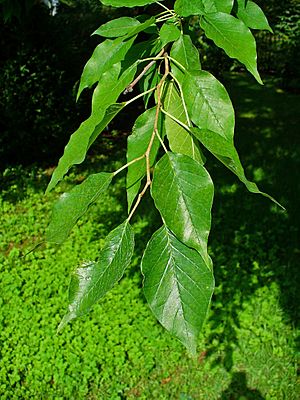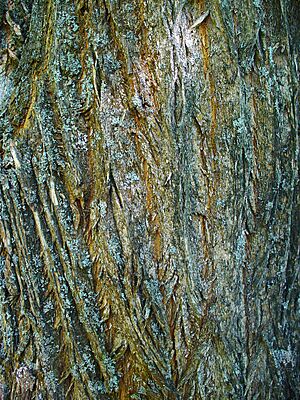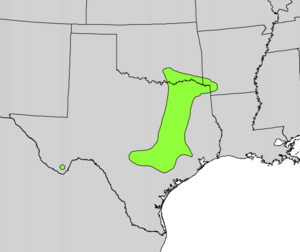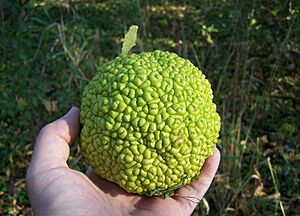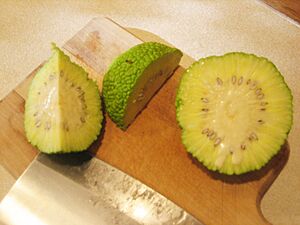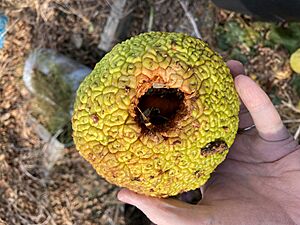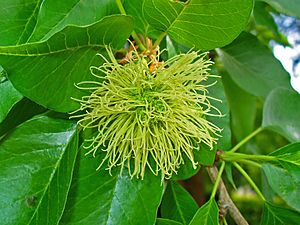Osage orange facts for kids
Quick facts for kids Osage orange |
|
|---|---|
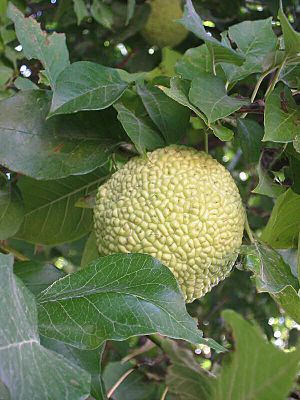 |
|
| Foliage and multiple fruit | |
| Scientific classification | |
| Genus: |
Maclura
|
| Species: |
pomifera
|
| Synonyms | |
|
|
The Maclura pomifera, commonly known as the Osage orange, is a fascinating small deciduous tree or large shrub. Being deciduous means it loses its leaves every autumn. It usually grows to be about 8 to 15 meters (26 to 50 feet) tall.
Even though it's called "Osage orange," this tree is not related to the oranges we eat. It actually belongs to the mulberry family, called Moraceae. It's known for its bumpy, green-yellow fruit and strong wood.
Contents
About the Osage Orange Tree
What is an Osage Orange?
The Osage orange tree is a unique plant. It can grow as a small tree or a large bush. It has shiny, bright green leaves that turn yellow in the fall. The branches often have sharp thorns, especially on younger trees.
The bark of a mature Osage orange tree is usually a deep orange-brown color. It can look furrowed or ridged. This tree is very tough and can grow in many different places.
Where Does the Osage Orange Grow?
The Osage orange tree is native to a part of North America. Its original home was in the south-central United States. This area includes states like Texas, Oklahoma, and Arkansas.
However, people have planted it in many other places. It can now be found across much of the United States. It is also grown in other parts of the world. This tree is very good at adapting to different soils and climates.
Its Unique Fruit
One of the most noticeable things about the Osage orange is its fruit. It looks like a bumpy, wrinkled green ball. It can be as big as a grapefruit or even larger. The fruit has a strong, citrusy smell.
Despite its name, the fruit is not good for humans to eat. It has a milky, sticky sap inside. Most animals also avoid eating the fruit whole. However, some animals, like squirrels, might chew into it to get the seeds.
Scientists believe that in the past, large animals like mammoths might have eaten and spread the seeds. These animals are now extinct. This is why the fruit often just falls to the ground and rots.
Why is it Called Osage Orange?
The name "Osage orange" comes from two parts. "Osage" refers to the Osage Nation. This is a Native American tribe that lived in the tree's native region. They used the tree for many purposes.
The "orange" part of the name comes from the fruit's appearance. It looks somewhat like a large, bumpy green orange. However, as mentioned, it is not a true orange.
Uses of the Osage Orange Tree
The Osage orange tree has been very useful throughout history. Its wood is incredibly strong and durable. It is also very resistant to rot.
Historical Uses
Native American tribes, including the Osage, used the wood to make bows. These bows were highly valued because of the wood's strength and flexibility. The wood was so good for bows that it was traded across North America.
Pioneers and farmers also found the tree useful. They planted rows of Osage orange trees to create living fences. The thorns on the branches made these fences very effective at keeping livestock in. These "hedgerows" were common before barbed wire became widely available.
Modern Uses
Today, Osage orange trees are still used for hedges and windbreaks. They can help protect fields from strong winds. The wood is also used for fence posts because it lasts a very long time in the ground.
Some people use the wood for woodworking projects. Its bright yellow color can be very attractive. The wood is also used as firewood because it burns very hot.
Life Cycle and Reproduction
The Osage orange tree reproduces using seeds found inside its large fruit. The trees have separate male and female plants. This means one tree will produce pollen, and another tree will produce the fruit.
The flowers are small and green. Wind carries pollen from the male flowers to the female flowers. After successful pollination, the female trees produce the large, bumpy fruits. These fruits ripen in the fall.
When the fruit falls to the ground, the seeds inside can sprout. This starts the life cycle of a new Osage orange tree.
Images for kids
See also
 In Spanish: Naranjo de Luisiana para niños
In Spanish: Naranjo de Luisiana para niños


